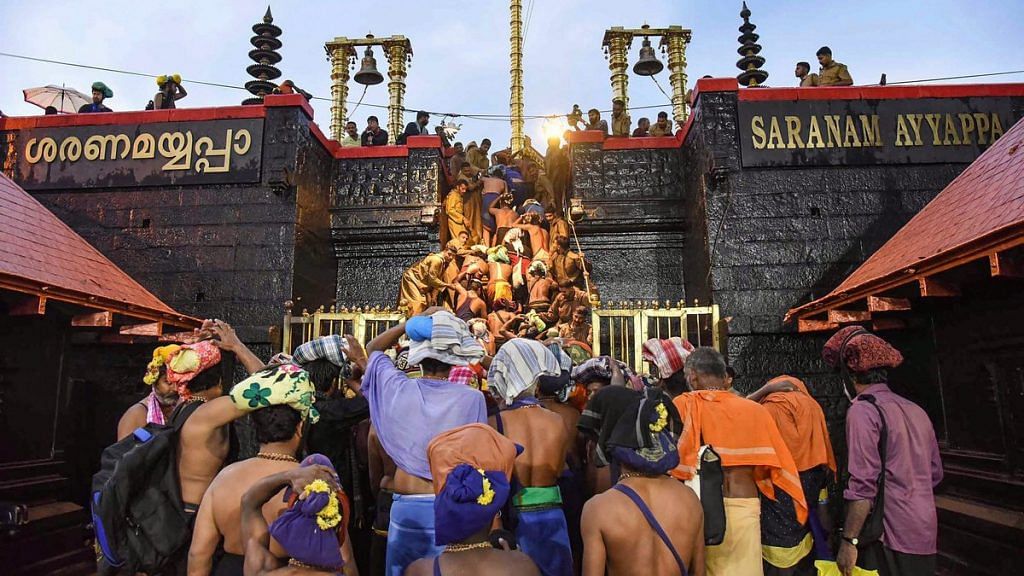Supreme Court should be wary of the increasing role that review petitions threaten to play in our jurisprudence.
The saga over Sabarimala continues to unfold. Rather than engaging with the interesting arguments on either side of the constitutional question, the response to the Supreme Court verdict has been troubling. This is not only because some have encouraged non-implementation of the decision, but also because otherwise thoughtful commentators have suggested that the protests following the verdict somehow expose its faults. This logic is fallacious. The legal merits of a judicial verdict do not turn on its popularity but rather on its reasons. We can, however, expect arguments of this kind to continue being made, for the issue is swiftly taking on a political life of its own.
While the political story develops, there is a different concern that needs addressing, namely that the issue may also take on a legal life of its own. The Supreme Court has agreed to hear the Sabarimala case for a review petition in open court. Such a hearing is, of course, permissible, but we should in general be wary of the emerging trend toward review petitions, and the increasing role that such petitions threaten to play in our jurisprudence. Will the court revisit the case? What standards will it use to answer this question? If it refuses to reopen the case, will a second review petition be filed? How will the permissibility of that petition be determined?
Under the Constitution, the Supreme Court – which serves as both an appellate and a constitutional court – represents finality. The judgments of the court are binding not only on non-judicial authorities but on lower courts too. Compliance is mandatory; and once a verdict is delivered, it is the verdict itself that constitutes the formal record.
Also read: Is Supreme Court right in making Rafale more urgent over Sabarimala and Ram Mandir?
The idea of finality is central to the rule of law. It is key to the law carrying coercive force, having meaning, and providing a result. In other words, it is sometimes more important for the rule of law that a matter be settled rather than it be settled right. Various legal doctrines capture this principle. As per the doctrine of functus officio, for example, a bench no longer exists after it has delivered a verdict, and this is the reason why when judges sometimes subsequently explain what their decisions truly mean, such explanations are to be disregarded. Similarly, the doctrine of res judicata prevents actions from being relitigated once they have already been adjudicated upon.
Review petitions are permitted under our constitutional schema. The Supreme Court’s power to review its own decisions is provided for in Article 137 of the Constitution. In all fairness, this power has been exercised with caution and discipline in the past. As a general matter, however, the court has over time been increasingly more willing to revisit its prior orders. This has been seen most glaringly in the development of “curative petitions”, where the court reviews a review petition. Here, as scholar Raeesa Vakil has powerfully argued, the court “may itself override constitutional provisions to create additional remedies”. Although curative petitions are rare, as is the case with first review petitions, they encourage the move from judicial finality.
Why should we suddenly worry about this? The question of first and second review petitions – and other features of the Supreme Court’s jurisdiction – is not new, but it is worth underlining at this moment because of the recent verdict in the Section 377 case. Although the court in that case delivered an admirable and important verdict and overruled its poorly reasoned previous decision, which had upheld the criminalisation of “unnatural sex”, the verdict said little about the precise principles by which the court’s jurisdiction was exercised. It did not explain the relationship between fresh appeals and curative petitions, both of which appear to have been filed in that case.
Also read: Why Sabarimala issue leaves instinctive liberals like me torn: Shashi Tharoor
Such procedural issues are rarely raised because we sometimes have verdicts that favour us, as in the Section 377 case, and appealing before the Supreme Court, however hard it might be, seems easier than enabling legislative action. The Sabarimala moment, however, is an important one for Indian constitutionalism.
While debates ensue over religious accommodation and the enforcement of judicial orders, the court would do well to use the review petition to shed light on its own powers. After all, from special leave petitions to public interest litigation cases, vast areas of the court’s jurisdiction are mysteriously exercised. They are practices in urgent need of a theory. There are no valid grounds for a review of the Sabarimala verdict. But the review petition is nonetheless an opportunity for the court to clarify, explain, and limit its powers in the case of first and second review petitions.
The author is the co-editor of the Oxford Handbook of the Indian Constitution, is a junior fellow at the Harvard Society of Fellows.
